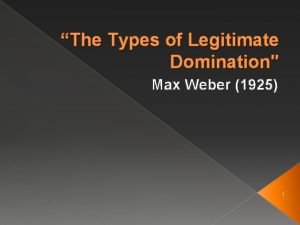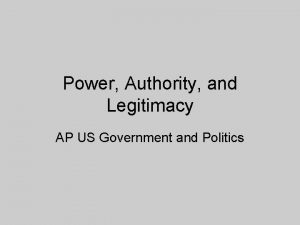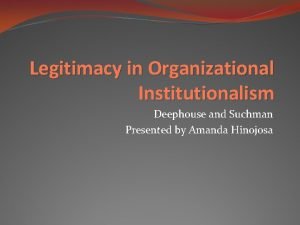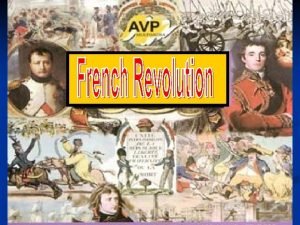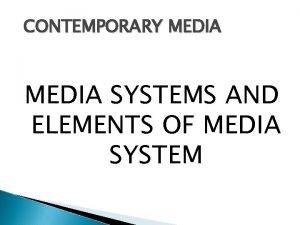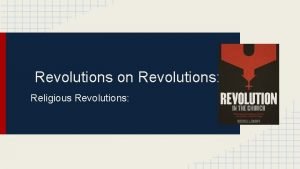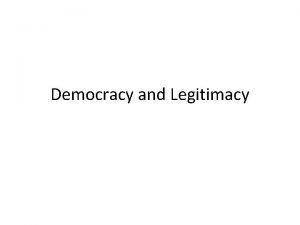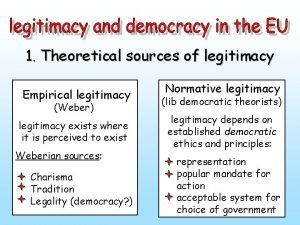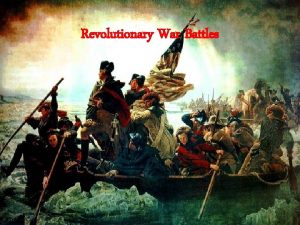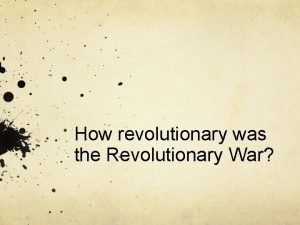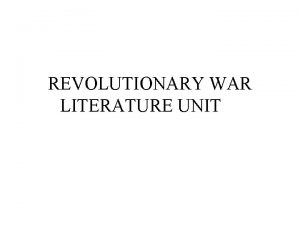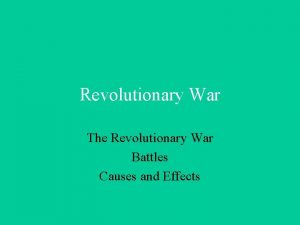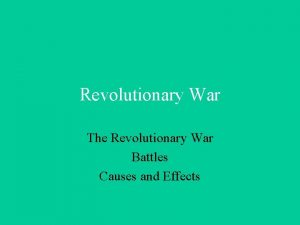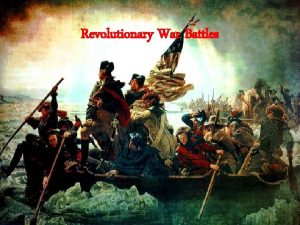Revolutionary Identity Revolutions create the legitimacy of the
















- Slides: 16

Revolutionary Identity Revolutions create the legitimacy of the new regime both by creating a new regime but also by shaping the development of the institutions that are designed to fulfill the revolution—the main criterion for legitimacy is whether or not the regime is living up to the revolution. Central to that task is the creation of a new identity for the citizens of the society. Much of America's political development has centered around this question: after the Revolution resolved that the basis of power would rest with “the people, ” defining this term became the central battle.

The preparation of a revolution is not the work of revolutionaries. That is the work of exploiters, capitalists, landowners, priests, police, officials, liberals, progressives and the like. Revolutionaries do not prepare, they make a revolution. Petr Tkachev, Russian revolutionary writer, 1876

American Revolution achieved long before 1776 Reason for its success Compare French (changes post-Revolution), Russian (receding), Chinese (post-Deng), Iran (fulfilling Mossadeq? ), Mexican (post-PRI) Nigeria: relevance of no revolution (independence “given” by British)? See: Jon Stewart

Britain Stereotypes: Political stability: no revolution in modern era Political evolution: adaptation institutions to new needs Another view: Imperial overreach and domestic change (economic, cultural)--> collapse of ancien regime and fitful creation modern capitalist democracy Like France and Russia (and Iran and China? )

Paid for in blood Charles I's imperial ambitions (Thirty Years War)--> need for money Parliament primarily tax collecting gentry; worried about crypto-Catholicism (see: Spain, Inquisition) 1627: Petition of Right (renewing Magna Carta): Charles “looks into abuses” 1629 -1640: Personal Rule/Eleven Years Tyranny— Charles + William Laud Problems: High-Anglicanism (+ Puritans; more later); Scottish rebellion

st 1 Civil 1640: Short Parliament (want guarantees, C refuses)--> Scots invade--> Long Parliament convene every 3 years; No taxes w/o P; P controls King's ministers; King can't dissolve w/o consent War Protestation: swear allegiance 1642: Irish Catholics rise up + failed attempt arrest Mps--> C flees--> Royalists/Cavaliers vs. Parliamentarians/Roundheads New Model Army (T. Cromwell): 1645 crush C's armies

nd 2 + rd 3 Civil Wars C regroups (w/ help Scots), 1647 -1649 3 rd Civil War: Ireland, Scotland, England 16491653 Brutal: all 3 --> 90, 000 deaths in England, 3. 7 percent of the population, a higher proportion than in either World War I or World War II; 60, 000 in Scotland, 6 percent of the population; and 660, 000 in Ireland, 41 percent of the population. (These figures include deaths from disease and starvation as well as battle casualties. )

Commonwealth and Protectorate Dec 1648: P debates King's return--> Pride's Purge--> Rump Parliament--> High Court to try Charles for Treason--> beheaded (30 January 1649)--> Commonwealth of England Rump conservative; Army radical: pushed religious tolerance --> Barebones Parliament: split Radical, Moderate, Conservative--> Cromwell dissolves-> Protectorate (1653 -58)--> Cromwell dies--> disintegrates--> Restoration of Charles II (1661)

Outcomes Structural Parliamentary monarchy: future kings avoid pushing P too hard 1688: Glorious Revolution; Bill of Rights 1701: Act of Settlement (succession) Acts of Union 1707: Great Britain (E+S); 1801: United Kingdom (E+S+I) Political parties: Tories and Whigs

Cultural Whig myth of English liberties Vicious anti-Catholicism (and Bloody Mary and Guy Fawkes) + Anglican fundamentalism (Henry VIII and Sir Thomas More; Laud cut off ears)--> religious tolerance Divine Right Monarchy (Tudor myth and James I's “little Gods on Earth”)--> myth of Magna Carta, parliamentary monarchy, contract theory, Princess Di

Short Course Russian Revolution 1904 -05: Russo-Japanese War 1905 Revolution--> empty Duma 1917: February: liberals + Provisional Gov't October: Bolsheviks (Mensheviks) 1918 -1923: Russian Civil War: Reds vs. Whites War Communism; Western interference 20, 000 died (war, disease, famine) 1924: Lenin dies; Stalin ousts Trotsky 5 -year Plans; Collectivization; Great Purges and Gulag Archipelago (10 -30 million) 1953: Stalin dies; Khruschev 1956: “Secret Speech”

Critical Periods US: 1783 -1787 1776 Independence--> rev'y gov'ts--> Continental Congress (reps of colonies)--> central gov't of Articles of Confederation unicameral, no exec, no nat'l judiciary, no army, no tax, equal rep by state--> GW: “little more than the shadow w/o the substance” Tariff wars, hyperinflation, debtor relief laws, debt, Western Indians and British But: wins war, pays down domestic debt, treaty w/Spain Russia: 1987 -1992 Perestroika (1987): political + economic “restructuring”: multicandidate (not party) elections, called Party Conference; Law on State Enterprise: output based on demand, private ownership certain sectors Glasnost: “openness; ” get around apparatchiks (agent of the apparatus) Secession crisis 1991 coup, Yeltsin gains power 26 December USSR dissolves Commonwealth Independent States Largely symbolic, few supranational powers, coordinates trade, transnational crime, democratization

Phila. Constitutional Convention (P Henry: “I smell a rat”): Virginia (large pop): 3 branches, bicameral, many powers, rep by pop and $ New Jersey (small pop): 3; unicameral; few (tax, limited trade); equal rep Conn. Compromise: 3 , bi-, powerful, H: pop; S: equal (2) 1993: Yeltsin’s “shock therapy” [neoliberal “Washington Consensus” (IMF, World Bank): 1) liberalization (reduce role government), 2) stabilization (budget), 3) privatization (rise of oligarchs)] economic and political crisis bombards Duma consolidates power (bans opp parties, arrests) new structure (Federal Assembly) + increased Pres power via referendum to create Constitution (December 1993) [Pres appoints PM + military leaders w/o Duma consent, vote no confidence toothless, no impeachment violate Const, etc. ]

US Art 1: Legislature Section 8: powers granted (1 -818: Necessary and Proper); Section 9: powers denied; Section 10: powers denied to the States Articles: “ 2. Fundamental human rights and freedoms are inalienable and shall be enjoyed by everyone since the day of birth. ”; 3. Man and woman shall enjoy equal rights and freedoms and have equal possibilities to exercise them. ; “ 1. Maternity and childhood, and the family shall be protected by the State. ”; “Everyone shall be obliged to preserve nature and the environment, carefully treat the natural wealth. ”] Art 2: Executive Commander-in-chief [if] Art 3: Judiciary Supreme Court and jurisdiction Art 4: Relations with the States Guarantee “republican government”; full faith and credit and privileges and immunities national citizenship Art 5: Amendment process Art 6: Debts, Supremacy Clause, no religious test Art 7: Ratification (9/13) Russia 1. Fundamentals of the Constitutional System 2. Rights and Liberties of Man and Citizen [extremely detailed and broad: 47 3. Russian Federation 4. President 5. Federal Assembly [Fed Council / Duma] 6. Government [Ministers] 7. Judiciary 8. Local Self-Government 9. Constitutional Amendments and Revisions

We the People of the United States, in Order to form a more perfect Union, establish Justice, insure domestic Tranquility, provide for the common defense, promote the general Welfare, and secure the Blessings of Liberty to ourselves and our Posterity, do ordain and establish this Constitution for the United States of America.

"We, the multinational people of the Russian Federation, united by a common fate on our land, establishing human rights and freedoms, civic peace and accord, preserving the historically established state unity, proceeding from the universally recognized principles of equality and selfdetermination of peoples, revering the memory of ancestors who have conveyed to us the love for the Motherland, belief in the good and justice, reviving the sovereign statehood of Russia and asserting the firmness of its democratic base, striving to ensure the well-being and prosperity of Russia, proceeding from the responsibility for our Motherland before the present and future generations, recognizing ourselves as part of the world community, adopt the Constitution of the Russian Federation. "
 Traditional legitimacy
Traditional legitimacy Traditional legitimacy
Traditional legitimacy Legitimacy ap gov definition
Legitimacy ap gov definition Legitimacy in organizational institutionalism
Legitimacy in organizational institutionalism Jika noel(create(q)) adalah 0 maka front(create(q)) adalah
Jika noel(create(q)) adalah 0 maka front(create(q)) adalah Social identity mapping
Social identity mapping Lemuel hayes revolutionary war
Lemuel hayes revolutionary war Famous virginians
Famous virginians Music of the revolutionary war
Music of the revolutionary war American revolution interactive notebook
American revolution interactive notebook Boston tea party diorama ideas
Boston tea party diorama ideas Revolutionary war jeopardy
Revolutionary war jeopardy What served as the seed of activism?
What served as the seed of activism? Revolutionary princess eve chapter 5
Revolutionary princess eve chapter 5 Abc revolutionary war
Abc revolutionary war Types of media systems
Types of media systems American revolt
American revolt

